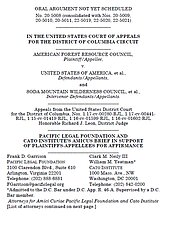Under the Antiquities Act, presidents are authorized to preserve landmarks by regulating the “smallest area compatible” with their protection. But instead of identifying a discrete object, Obama reasoned that the entire area contains ill‐defined “ecosystems,” which are themselves “monuments.” The problem, of course, is that every square inch of earth’s surface contains or is otherwise part of an ecosystem. By drawing lines on a map, and then declaring all “ecosystems” therein to be a composite monument, Obama effectively skirted any constraints on the president’s power to regulate public lands.
In addition to undermining limits established by the Antiquities Act, President Obama’s unilateral expansion of the Cascade-Siskiyou National Monument contravened another statute. Under the Oregon and California Railroad and Coos Bay Wagon Road Grant Lands Act of 1937 (O&C Act), Congress created a system for harvesting timber on almost 2 million acres in western Oregon. Despite the O&C Act’s requirement that timber grown on the land “be sold, cut, and removed in conformity with the princip[le] of sustained yield,” Obama incorporated nearly 40,000 acres of O&C land into the newly expanded monument, and he ordered that logging cease in this area.
The timber industry sued in a federal district court, arguing that the expansion of the Cascade-Siskiyou monument is “ultra vires,” or beyond the president’s authority, because it conflicts with both the Antiquities Act and the O&C Act. In response, the government argued that the president’s power cannot be questioned by courts due to his unique constitutional status as the head of the Executive Branch. Ultimately, the district court sided with the plaintiffs, and the government appealed. The case is now before the D.C. Circuit.
Today, the Cato Institute joined the Pacific Legal Foundation filed an amicus brief in support of the challengers. We argue that courts have a constitutional duty to check the president’s claims of unfettered regulatory authority under the Antiquities Act.




